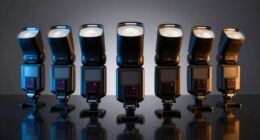Exploring the complexities of hearing loss linked to tinnitus, we unveil crucial understandings about its detection, treatment, and potential outcomes.
By emphasizing collaborative diagnostic approaches and tailored evaluations, this guide aims to shed light on the diverse landscape of tinnitus characteristics.
As we navigate through treatment options, preventive measures, and associated secondary conditions, a deeper understanding of the interconnected nature of hearing loss and tinnitus emerges.
Stay tuned to unravel the intricate web of considerations surrounding this pressing issue in audiology.
Key Takeaways
- Tinnitus-related hearing loss stems from inner ear damage and emotional factors.
- Diagnosis involves history, physical exam, audiologic tests, and imaging studies.
- Prevent hearing loss by using ear protection, avoiding loud noises, and regular screenings.
- Treat tinnitus-related hearing loss with aids, therapy, sound techniques, and collaborative care.
Etiology of Tinnitus-Related Hearing Loss
Prolonged exposure to loud noises can lead to damage in the inner ear structures, resulting in tinnitus-related hearing loss. This damage often affects the delicate hair cells within the inner ear, contributing to sensorineural hearing loss.
The connection between tinnitus and anxiety is crucial, as heightened stress levels can worsen tinnitus symptoms and impact overall auditory function. Individuals with chronic tinnitus may experience changes in auditory processing, which can manifest as difficulties in speech discrimination and sound recognition.
Research indicates a direct relationship between the severity of tinnitus symptoms and the degree of hearing loss individuals may encounter.
Understanding the intricate interplay between tinnitus, inner ear damage, and emotional factors like anxiety is vital in comprehending the complexities of tinnitus-related hearing loss. By recognizing how exposure to loud noises can harm the inner ear's delicate structures, particularly the hair cells, we gain insight into the mechanisms underlying sensorineural hearing loss. This knowledge can guide interventions aimed at managing tinnitus and preserving auditory function effectively.
Diagnosis and Evaluation Methods

Damage to the inner ear structures from prolonged exposure to loud noises necessitates a thorough diagnostic approach for assessing tinnitus-related hearing loss, focusing on comprehensive evaluation methods. When diagnosing tinnitus-related hearing loss, healthcare providers typically start with a detailed history, a physical exam, and an audiologic evaluation to understand the extent of hearing impairment. Specific tinnitus characteristics such as pulsatile sounds or asymmetry may require urgent evaluation to rule out underlying issues. In cases of unilateral, pulsatile, or asymmetric tinnitus, imaging studies, particularly MRI, are recommended to identify potential structural abnormalities. Collaboration among various healthcare professionals is crucial for a holistic evaluation of tinnitus, ensuring that all aspects of the condition are addressed. While laboratory tests may not provide definitive answers for tinnitus causes, imaging studies play a vital role in pinpointing treatable conditions that could be contributing to hearing loss.
| Evaluation Method | Description | Importance |
|---|---|---|
| History taking | Detailed exploration of symptoms, triggers, and medical history to understand the tinnitus presentation. | Foundational for diagnosis |
| Physical exam | Examination of the ears, head, neck, and neurological system to identify any physical indicators of tinnitus. | Essential for clinical assessment |
| Audiologic evaluation | Assessment of hearing function through various tests like audiometry to quantify hearing loss. | Key in determining the extent of hearing impairment |
| Imaging studies | Utilization of imaging techniques such as MRI to visualize inner ear structures and identify potential causes. | Crucial for identifying structural abnormalities |
Understanding the nuances of these evaluation methods is fundamental in diagnosing and addressing tinnitus-related hearing loss effectively.
Prevention Strategies for Hearing Loss
Utilizing ear protection and controlling exposure to loud environments are key strategies in the prevention of hearing loss. Avoiding prolonged exposure to noises above 85 decibels is crucial as it can prevent noise-induced hearing loss. When in noisy settings, using ear protection like earplugs or earmuffs can significantly reduce the risk of hearing damage. It's important to limit the volume and duration of headphone use, especially in loud environments, to protect your hearing.
Regular hearing screenings and assessments play a vital role in detecting early signs of hearing loss, allowing for timely intervention. Educating oneself and others on the significance of hearing protection and safe listening practices is essential for preventing hearing loss. By being proactive in implementing these prevention strategies, individuals can safeguard their hearing health and reduce the risk of developing hearing loss due to noise exposure. Remember, prevention is key in maintaining good hearing health.
Treatment Approaches for Tinnitus-Related Hearing Loss

To address tinnitus-related hearing loss, individuals may explore various treatment approaches aimed at alleviating symptoms and improving auditory function. When dealing with hearing loss secondary to tinnitus, it's essential to consider a range of interventions tailored to individual needs.
Here are five key treatment approaches worth exploring:
- Hearing Aids: Utilizing hearing aids can help amplify external sounds, making it easier for individuals to communicate and engage in daily activities.
- Cognitive Behavior Therapy: This therapeutic approach can assist in managing the distress often associated with tinnitus-related hearing loss, enhancing coping mechanisms and overall well-being.
- Sound Therapy: Techniques like white noise or masking devices can provide relief by helping to distract from the tinnitus sounds and promote relaxation.
- Cochlear Implants: In more severe cases, cochlear implants or other implantable devices may be considered to manage hearing loss linked to tinnitus.
- Communication Strategies: Implementing effective communication strategies can enhance interactions and relationships, improving overall quality of life for those experiencing tinnitus-related hearing issues.
Anticipatory Guidance for Tinnitus Management
How can we effectively guide individuals in managing their tinnitus through anticipatory strategies and education on coping mechanisms?
Anticipatory guidance for tinnitus management is crucial in helping individuals navigate the challenges associated with this condition. By providing information on the natural course of tinnitus and offering coping strategies, we empower individuals to better understand and cope with their symptoms.
Educating patients on preventive measures such as avoiding noise exposure and using ear protection can significantly impact tinnitus management outcomes. Early intervention through cognitive behavior therapy (CBT) has shown to improve patient outcomes, highlighting the importance of timely support.
Additionally, educating individuals on the benefits of cognitive training and melatonin in tinnitus management can enhance their quality of life. Emphasizing a collaborative approach with healthcare providers ensures a comprehensive and tailored strategy for tinnitus management, ultimately leading to improved patient care.
Frequently Asked Questions
How Do You Deal With Hearing Loss and Tinnitus?
Dealing with hearing loss and tinnitus can be challenging, but seeking professional help is essential. Diagnosis and exploring treatment options such as hearing aids or sound therapy are crucial steps.
Joining support groups, informing others about our condition, and using assistive technologies can help us cope. Understanding the relationship between hearing loss and tinnitus empowers us to navigate these challenges and access appropriate care for both conditions.
What Is the New Tinnitus Treatment 2023?
We've discovered an exciting new tinnitus treatment for 2023!
Transcranial magnetic stimulation (TMS) is at the forefront, using magnetic fields to target tinnitus-related brain activity.
Studies show TMS can reduce tinnitus severity and distress.
By offering relief to those with chronic tinnitus, this innovative therapy is paving the way for future treatments.
Ongoing research and trials are delving deeper into TMS effectiveness and long-term benefits.
How Do I Win a VA Claim Secondary to Tinnitus?
To win a VA claim secondary to tinnitus, we must establish a clear link between the primary tinnitus diagnosis and the secondary condition, like hearing loss. Strong medical evidence showing how tinnitus impacts the development or worsening of the secondary condition is crucial.
Detailed documentation from audiologists and physicians should outline this relationship. Highlighting the functional limitations and disability caused by the secondary condition affected by tinnitus strengthens our case for VA disability benefits.
What Are 5 Conditions Secondary to Tinnitus?
Certainly!
Five conditions commonly linked to tinnitus include migraines, anxiety, depression, Somatic Symptom Disorder (SSD), and Meniere's Syndrome.
Research demonstrates a strong connection between tinnitus and migraines, anxiety, and depression.
SSD can affect daily life, leading to VA disability ratings.
Meniere's Syndrome, with symptoms like hearing loss and dizziness, can worsen overall health.
These conditions highlight the significant impact tinnitus can have on various aspects of well-being.
Conclusion
As we journey through the realm of tinnitus-related hearing loss, let's envision a symphony of solutions harmonizing with our ears. Together, we navigate the intricate pathways of diagnosis, prevention, and treatment, guided by the light of knowledge and collaboration.
Embrace the melody of hope and empowerment as we strive to manage tinnitus with resilience and grace. Let's stand strong, united in our quest for better hearing health.











